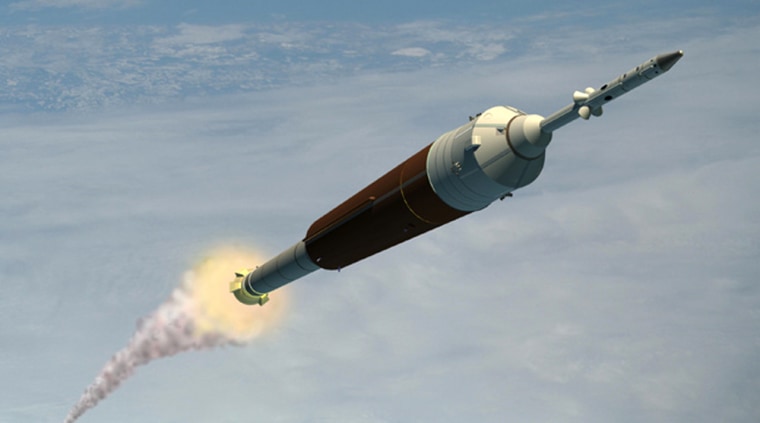With NASA’s announcement that aerospace firm Lockheed Martin will build its shuttle successor Orion, the agency is forging ahead with a test flight plan for the rockets to launch those future vehicles spaceward.
NASA is targeting April 2009 to test the first stage of its Ares 1 rocket, a five-segment booster evolved from its four-segment solid rocket boosters used to launch space shuttles into orbit. The rocket will launch astronaut crews into orbit to either dock at the International Space Station or press onward to the Moon — though the latter would require rendezvous with a lunar lander and Earth Departure Stage launched by the planned heavy-lift Ares 5 rocket.
“It’s a proof of concept that we’re going to take this solid rocket motor that was designed for the shuttle, and we’re going to use it in this new application,” said Jeff Hanley, manager of NASA’s Constellation program. “We’re going to look at the dynamics at the separations between the first stage and a facsimile of the upper stage.”
Known as Ares 1-1, the first stage test will launch an inert — but instrumented — second stage and mock-Orion vehicle to suborbital heights to evaluate the SRB’s thrust and roll control.
“We don’t want to put [cryogenic propellant] in this vehicle,” said Steven Cook, NASA’s exploration launch projects manager, of the simulated second stage for Ares 1-1. “We just want to get it as dynamically similar as possible to the actual launch vehicle.”
NASA has budgeted about $300 million for the initial Ares 1-1 tests, which include the April 2009 launch from Pad 39B at the Kennedy Space Center, as well as a second space shot six months later if necessary, Hanley added. The final, two million-pound (907,184-kilogram) rocket is expected to be able to boost a 25-ton payload into orbit and will be hauled to the launch pad atop NASA’s Mobile Launch Platform by an existing Crawler transport.
Hanley said the first full-up Ares 1 launch is expected to lift off in June 2012, with the first orbital space shot with astronauts aboard slated for September 2014. That crewed launch, he added, would be the third of four orbital test flights.
NASA’s Ares 1 rocket will stand about 309 feet (94 meters) tall and consists of primarily of two stages capped by the Orion crew capsule and a four-engine escape tower. According to a NASA description, Ares 1’s first stage — the SRB-derived booster — is reusable, and propels Ares 1 to a speed of about Mach 6.1 and an altitude of about 200,000 feet (60,960meters) before separating 2.5-minutes into flight and falling back to Earth on parachutes.
The second stage harbors the liquid oxygen/liquid hydrogen fueled J-2X engine, an evolution of NASA’s Apollo-era Saturn V J-2 motor and the never-flown J-2S version. It is that upper stage that will propel the Orion crew capsule to an altitude of about 63 miles before separating, with the spacecraft’s service module completing the trip to a 185-mile (297–kilometer) orbit.
An interstage segment connects the Ares 1-1 first stage with its simulated upper segment — which will fall into the Atlantic Ocean after separating — and also holds the roll control and separation engines for the test flight, Cook said.
Slideshow 12 photos
Month in Space: January 2014
During the first Ares 1-1 test, the first stage is expected to burn for about 130 seconds, reach a speed of about Mach 4 and an altitude of 250,000 feet (76,200 meters), Cook said.
Like the four-segment SRBs used in space shuttle launches, the Ares 1-1 first stage will burn a star-shaped mix of the solid propellant polybutadiene acrylonitrile (PBAN), though the final mix and rocket nozzle designs have yet to be determined, NASA officials said. One of the five segments comprising the Ares 1-1 first stage will also be a dummy unit, since the first full-up booster will not be ready until later in 2009, they added.
“We believe we’ll be able to get enough similarity to be able to anchor our models, which is really the reason for these flight tests,” Cook said, of the decision to use the dummy SRB segment.
ATK Thiokol has already ground-tested a five-segment SRB during a 2003 study of booster performance and margins for the shuttle program. But Thiokol officials said that the goals of that test were quite different than those required to crew-rate the Ares 1 rocket.
“The real proof in the pudding will be in this flight,” Cook said of the Ares 1-1 test. “And we’ll see if we need to make any changes before we go into final production.”

